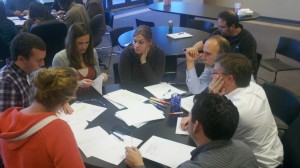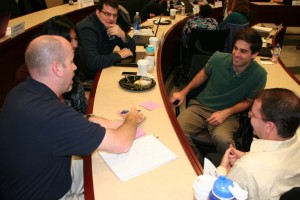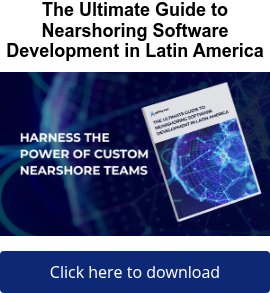It’s been over a year now since I started AgilityFeat, and what a great year it’s been. Being December, this is also a good time to get reflective as the year draws to a close. With that in mind, I’ve come up with a list of twelve lessons I’ve learned over the last year. I suppose you could try to sing it to the tune of “The Twelve Days of Christmas”, but I don’t recommend it. 🙂
I’ve spent the last six years of my career either as a self-employed consultant or working for small consultancies, and some of these lessons applied to those past experiences too. Others I’ve learned more recently because being a self-employed Agile Coach is pretty different than being a contract software developer.
In no particular order, here we go….
Lesson #1: Peer networking is key for learning and support
One of the best decisions I made a year ago was to join one of Michael Spayd and Lyssa Adkins Coaching Circles. For six months Michael would lead a conference call with 5 or 6 of agile coaches. Usually he started off with a topic to teach us about, and then we would coach each other through real-life or theoretical scenarios that agile coaches regularly faced.
Since the circle formally ended, most of us have kept going and we still talk to each other once or twice a month. This has been an invaluable experience for me. When you are an agile coach, you will at times feel alone on the client site. You’re an outsider trying to change things, and not everyone wants to change. Sometimes you’ll face resistance but it’s hard to get the moral support and advice you need from your client. So having a peer group that you can regularly talk things through with will help you feel energized and provide the support you need to work through any frustrations you are encountering.
Sounds a little touchy-feely perhaps, but it really is useful.
Lesson #2: Stances/Powerful Questions
One of the other things I’ve learned from multiple sources is the importance of “powerful questions.” It’s very tempting to immediately tell the client what they need to fix, but the changes you seek will last longer if you instead help the clients figure out the solution themselves. Set your ego aside, don’t beat them over the head with advice, but instead challenge them and hold them accountable for the solutions you come up with together.
Sometimes you do need a training or teaching stance, where you are simply handing out answers. That’s okay, but you also need to learn when to not just blurt out the textbook agile answer.
Lesson #3: Is multi-tasking a necessary evil?
This is still a lesson I am learning. One thing that we agile coaches like to tell our clients is that they need to stop juggling so many open projects, and just focus on getting some things done and out the door.
But as an agile coach, I don’t take my own advice. I balance multiple clients at once, plus the sales efforts necessary to line up my next set of clients. Fortunately I like to multi-task, but at what point am I spreading myself too thin? I don’t have the exact answer to that yet, and I am still learning how best to strike that balance.
Lesson #4: Partnerships are key
When you are self-employed, there are two big stressors. The first is how to win projects. In my experience, the key is partnerships. I have spent a lot of time networking with fellow coaches and agile consulting companies at conferences over the last year or two, and those relationships are paying off.
Some of my work comes from my own one-on-one sales to customers I know or met when I gave a speech at a conference or user group. I expect that will increase over time as I become better at selling myself, and that’s good since the margins are better in that case. But most of my work currently comes from other companies who sub-contract agile coaching or training to me. That’s where building partnerships has been key for me.
Lesson #5: Be patient on billing, but remain diligent
Winning customers is one thing, but the second biggest stressor when you are self-employed is getting those customers to actually pay you. Before you make the leap to independent consulting, consider the “runway” of funds you have to pay yourself. You’re going to work for 2-4 weeks before you send your client the first invoice. Most of the time, you’ll be asking them to pay you within 30 days. And most of the time they will be late (at least on the first invoice in my experience). So it can easily be 60-90 days after you actually do the work before the check from the customer arrives in the mailbox.
You’re going to have to be patient, but don’t be shy. Remain diligent and on top of those outstanding payments. They’re not trying to stiff you, but they will need a respectful prod every now and then.
Lesson #6: Say Yes before No on your availability
A good number of my leads come from these partnerships that I mentioned earlier, and from recruiters that I network with on LinkedIn or Twitter. I also regularly write proposals for projects.
So when someone calls me and says “Are you interested in project X next [quarter/month/week]?”, I am always tempted to say No, but stop myself and say Yes instead.
I’m tempted to say No because I know there’s a chance my current client will extend the project I’m on. I’m also tempted to say No because I know that I’ve submitted a proposal or two, and talked to a couple of peers about other potential projects they would like help with. I’m worried that I will be overbooked, and so I’m tempted to say No.
But then my business sense sets in, and I say “Yes, I’m interested – tell me more!” Because I have to remember that most of those opportunities, in fact the vast majority of them, are not going to come through.
Some of the best advice I’ve gotten from previous employers and business development folks I’ve known is that you will probably have to submit 20 proposals before you get your first customer to award you a project.
I keep that same ratio in mind when I’m talking to recruiters and peers about potential work. They do all sound very interesting, and I am truly interested in them, but I also know that only 1 in 20 will work out.
Lesson #7: Just Say No if it’s not a good fit
The corollary is that you will need to resist the temptation to say yes to every project that comes along, just because you are worried about meeting the bottom line. When you first get started, you should probably take whatever you can get because you will be hungry for work and past client experience.
However, sometimes you still need to say No if you know it will be unprofitable work or it is a client that is likely to put you in a situation you cannot succeed in. You’ll develop that intuition with time.
More recently, I’ve been in the pleasant situation of starting to say No to work because I simply know that I don’t have the time for it. This is nice too since it allows me to be a little more selective about the type of projects I take on.
Lesson #8: Journal as you go
I haven’t journaled this much since middle school English class. I try to keep weekly journals on my major coaching engagements, and post-project journals for smaller engagements.
I keep a running list of how I provided value to the client. That keeps me motivated and focused on all the small wins I am helping them achieve, which is especially helpful if the big wins are few and far between. I figure it also will help me if the client ever questions my invoices, although that hasn’t happened yet.
I also journal about the lessons I’ve learned as a coach, and areas I can improve on.
It’s not touchy-feely journaling, but it does help me to step back each week and reassess myself. I’ve also gone back to them when writing about past projects for proposals, or just trying to tackle a tough problem I’ve run into before
Lesson #9: Talk less and create more activities
For the classes and user group talks I’ve put together, I’ve learned to shut up a little more. I can really get talkative and give long speeches if I don’t watch myself. That’s why the book “Training from the back of the room” was so helpful to me.
I heard about that book from other coaches and trainers. I pay close attention now to how others run their sessions at conferences, and I’ve also utilized many of the tips in that book to create more games, quizzes, and activities to keep my training sessions more engaging.
It actually makes it harder for me as a trainer, because I’ll find myself creating twice as many power point slides as I can realistically fit in. But this is good – it forces me to focus on the things that really matter, and emphasize those things through hands on activities so people will truly learn it, and have less trouble staying awake!
Lesson #10: Don’t under price yourself
Speaking of training, I’ve definitely underpriced the custom training classes I’ve done this year. Even when I’m reusing material from a past training it still takes a lot of time to sell a class, to interview the client about what will be most useful to them, to customize the class to their needs, to update the materials and print handouts, and to do the follow up work.
All of that means that when I have sold a class at my normal hourly billing rate, it’s a money-loser. I bill for 8 hours of class time, but I also spent another 10-12 hours in order to be able to bill for that 8 hours.
I know I did that some this year, and that’s okay. I wanted the experience more than I wanted the larger invoice. But next year those same classes will sell for 3 or 4 times as much. Don’t worry, that’s actually still a pretty good price. 🙂
The same of course applies to setting your normal hourly rate. Keep in mind you have to pay for benefits, vacation, sick time, down time, marketing time, conferences, blogging time, etc. You’ll inevitably do a lot of that in off hours and on weekends, but you can’t just divide the salary you want by the number of weeks per year. In my experience, you’ll need nearly twice as much revenue as you want for your base salary.
Lesson #11: Don’t be afraid to fail
When I went to Agile Coach Camp in Columbus Ohio this year, I was in some great sessions with other agile coaches. In one of them I realized that I wasn’t being brave enough in the questions I asked my clients. I was taking their assumptions for granted, and not challenging them enough. I realized that I needed to give myself permission to ask tough questions, and that I needed to give myself permission to fail occasionally.
That courage is necessary, and I’ve become a better coach as I’ve become more brave in my questions to clients. Keep in mind there’s a difference between being a jerk and asking brave questions.
You should also be willing to stretch yourself, and sometimes that means failing. I’ve written a few articles this year and gotten them published. But I’ve also had some article drafts rebuked. While I didn’t enjoy the virtual smack-down of being told I was wrong, it was extremely valuable. I stretched myself beyond my comfort zone, and beyond my experience. And frankly, I failed some. But it was very valuable because it forced me to question my own assumptions, and I came out of it intellectually stronger.
Lesson #12: Social networking is a must
Many of my leads have come through LinkedIn and Twitter. Although most of those are among the projects that never signed on the dotted line, it was still valuable and helped get me on the short list of some companies who now regularly consider me for their proposals.
Although most of my work has actually come from the people I meet in person at conferences and trainings, social media has still enhanced those relationships and helped them lead to actual work. It’s an easy way to stay in touch, and helps to remind them that I am still out here if they ever want to send work my way.
I don’t tweet or blog nearly enough. But even with the limited amount I find time for, it is well worth it.
And the lessons go on…
The last year-plus has been an incredible experience, and I’m very happy with the path I’m on. I’ll keep learning as I go, and adjusting those lessons already learned. I can’t wait to see what the next year holds in store for me and my clients, and what additional successes and failures I will have that lead to even more learning!
If you’re just venturing into agile coaching or consulting, I hope these lessons will ring true for you and perhaps help you with your transition. I’d love to hear your feedback!













